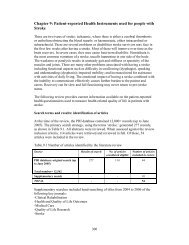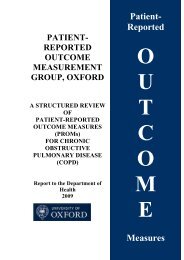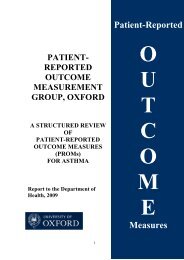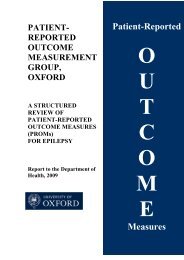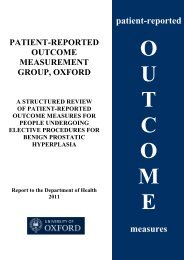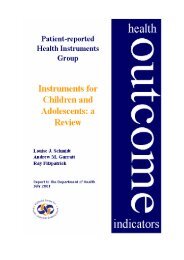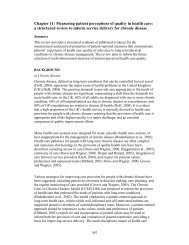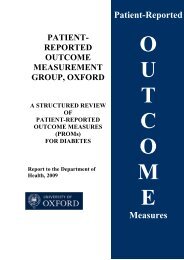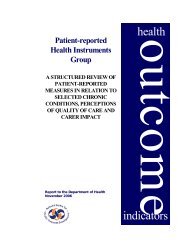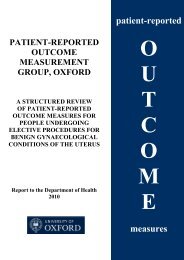2010 review - Patient-Reported Outcomes Measurement - University ...
2010 review - Patient-Reported Outcomes Measurement - University ...
2010 review - Patient-Reported Outcomes Measurement - University ...
You also want an ePaper? Increase the reach of your titles
YUMPU automatically turns print PDFs into web optimized ePapers that Google loves.
Responsiveness of the DASI was illustrated in the study by King (2000), with significant<br />
improvement in functional status for both genders. Significant score changes were reported<br />
for the CABG group in a study comparing outcomes among three groups of patients with<br />
advanced CAD (Kandzari et al., 2001; MOSS study). Significant improvement in DASI<br />
scores post-revascularisation was reported for the Canadian (but not the US) group in the<br />
GUSTO-IIb QoL substudy (Kaul et al., 2004). The DASI also demonstrated responsiveness<br />
in the survival study by Koch et al. (2007); however, distribution of scores was skewed, with<br />
a clustering of scores at the higher end of the range, suggesting the measure lacks precision<br />
for patients with better functional capacity.<br />
Interpretability of the DASI was supported in the 1997 study by Hlatky and colleagues where<br />
a small change in score (2.7 units) was found to be clinically meaningful.<br />
Ease of application, or feasibility, of the DASI is noted (Nelson et al., 1991).<br />
d. Heart Surgery Symptom Inventory, HSSI (LaPier & Jung, 2002)<br />
The HSSI was developed to provide a measure of functional status and QoL for patients in<br />
the subacute stage of recovery from CABG (from two to six months post-surgery). It covers a<br />
broader range of symptoms than most cardiac-specific measures, which focus principally on<br />
angina and dyspnoea. In its current form it is not appropriate for pre-operative assessments<br />
owing to the large number of surgery-specific items (LaPier & Jung, 2002). The developers<br />
suggest it could be readily adapted for use in the immediate post-operative period (up to two<br />
months) and/or during long-term recovery, i.e. beyond six months (LaPier & Jung, 2002);<br />
however, it has not yet been evaluated for this purpose (LaPier, 2006; LaPier & Wilson,<br />
2006).<br />
Three studies (the most recent being from 2007) and a <strong>review</strong> article were identified which<br />
evaluated the HSSI in US patients having undergone CABG.<br />
Content was derived from previously published qualitative studies, clinicians, and patients<br />
recovering from CABG; a preliminary list of items was revised and added to by a panel of<br />
specialist physical therapists (LaPier & Jung, 2002). The final version of the instrument<br />
comprises 76 items in five symptom categories - namely, cardiac; general (includes sleep,<br />
fatigue, sexual functioning, cognitive functioning); trunk (includes incision/drain site pain,<br />
wound healing); lower extremity (for those receiving grafts harvested from the saphenous<br />
vein); upper extremity (for recipients of radial artery grafts). Respondents are asked to assess<br />
symptoms over the previous week, selecting from five Likert-type response options. Domain<br />
scores are summed to produce a total, with lower scores indicating greater severity of<br />
symptoms.<br />
Internal consistency was supported by significant correlations between domain and total<br />
scores, and most inter-domain scores, in a study with a small sample of patients who had<br />
undergone CABG six months previously (LaPier, 2006). However, individual item-domain<br />
and item-total correlations ranged 0.01-0.85, with several values falling well below the norm<br />
of 0.20 (LaPier, 2006). Test-retest reliability was supported by significant correlations<br />
between HSSI scores on two administrations; however, these were conducted on the same<br />
day, and results could therefore be subject to recall bias (LaPier, 2006).<br />
26



